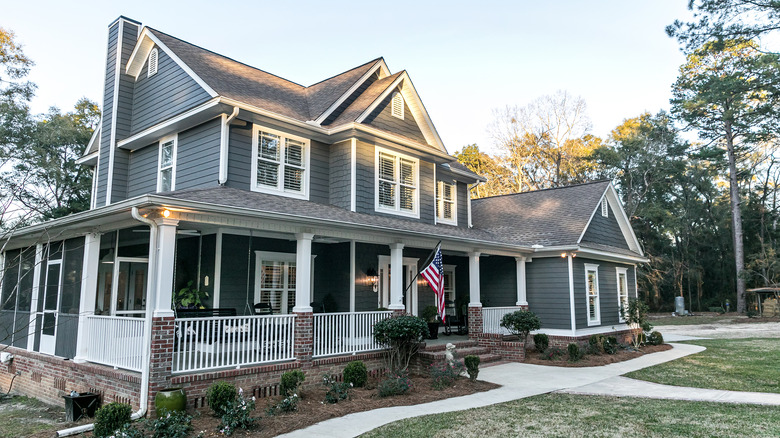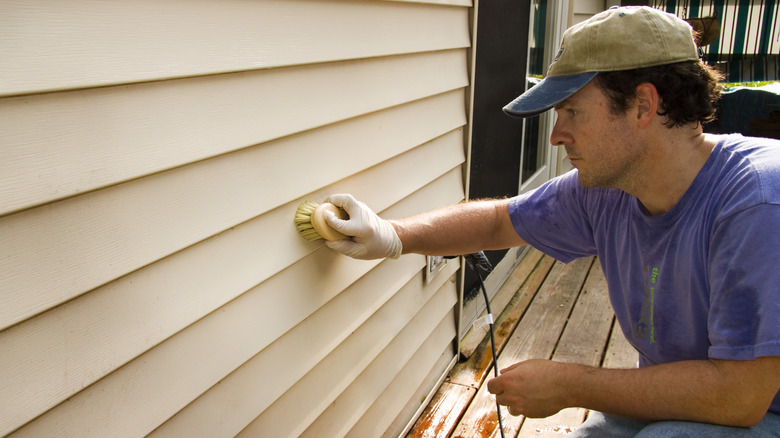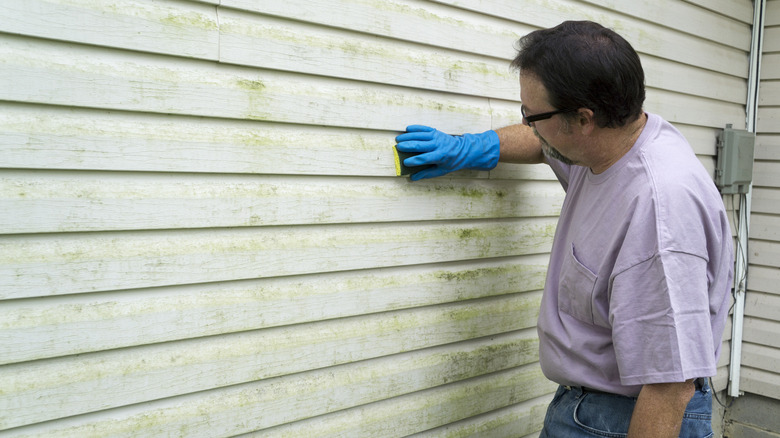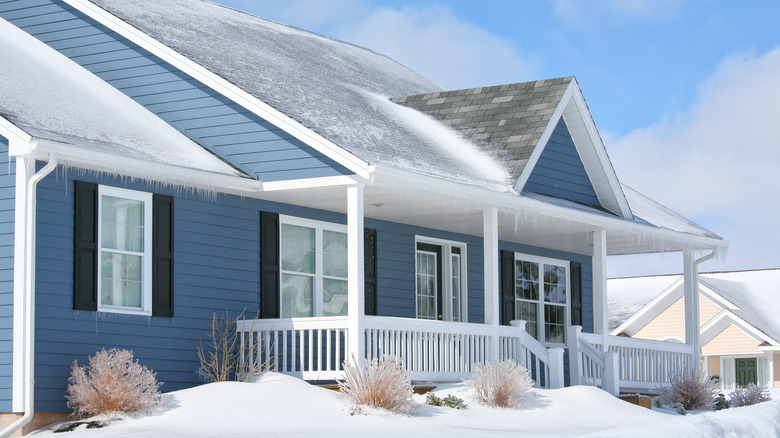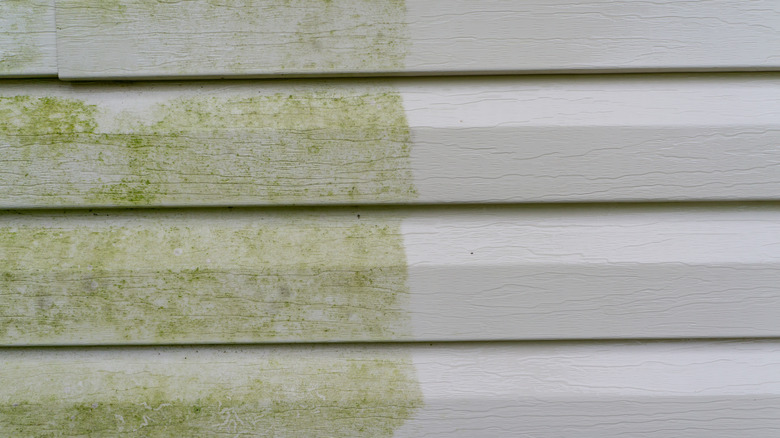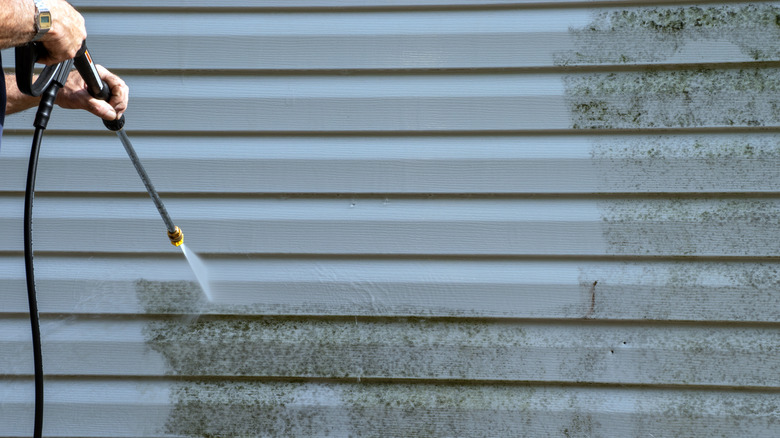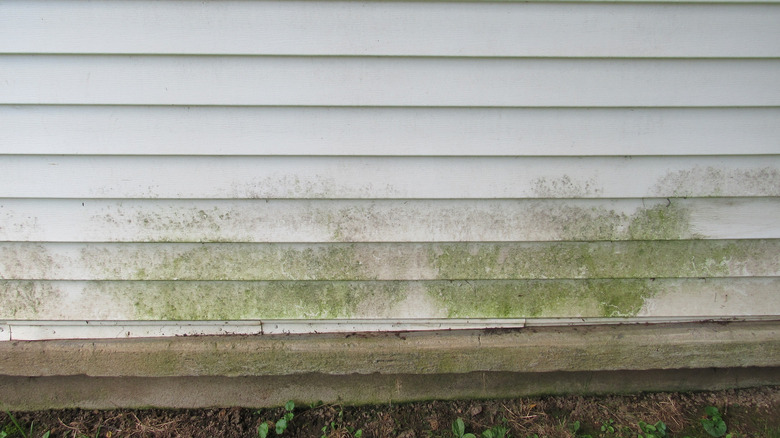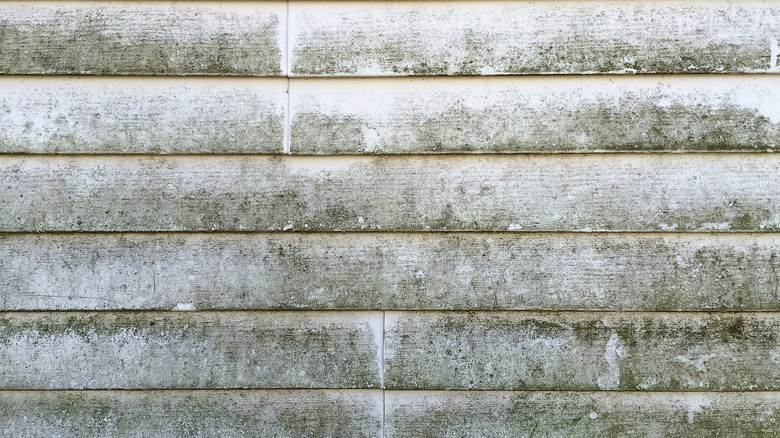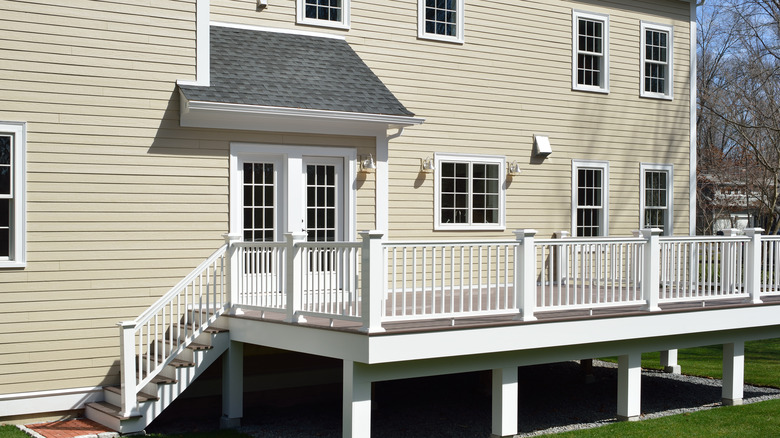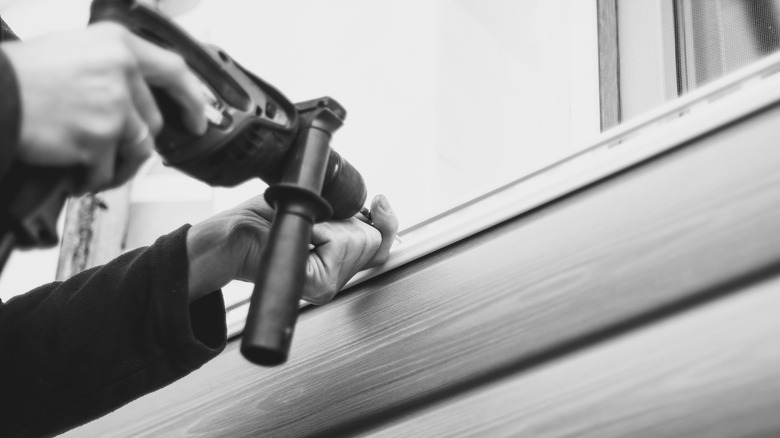How To Make Your Vinyl Siding Look New Again
Vinyl siding is a popular exterior covering for houses due to its economical price, durability, energy efficiency, and minimal maintenance requirements. But when it starts to look old, dirty, and faded, you'll want to take steps to make your vinyl siding look new again. The simplest step is to clean your vinyl siding once a year. Several options for cleaning solutions include homemade mixtures as well as commercially prepared cleaners that are formulated for vinyl siding. It's important to observe proper cleaning methods such as washing with a soft brush and rinsing with a garden hose. You can even use a power washer if you follow specific protocols to avoid damaging the siding. In addition to cleaning, a vinyl restorer gives new life to siding.
Stains and ugly smudges on vinyl siding may result from living organisms such as algae and fungi that produce mildew and mold. It's important to remove these growths before they cause real damage to your home's structure. Additionally, you may need to replace individual pieces of siding that show signs of splitting, cracking, or buckling. If thorough cleaning and repairs do not produce the results you want, you can paint your vinyl siding with acrylic paint to give it a fresh, new appearance.
Clean vinyl siding with vinegar and water
You can make a DIY cleaning solution of 30 percent vinegar and 70 percent water to rid your vinyl siding of dirt, stains, and light mildew. In a large bucket, mix 5 cups or 1.2 quarts of vinegar with 11 cups or 2.8 quarts of warm (not hot) water. Rinse the siding with a garden hose before cleaning to remove the loose dirt. Then, use a cloth or long-handled brush with soft bristles to wash the siding with the vinegar mixture. Avoid abrasive tools when cleaning your siding. After washing, rinse the vinegar solution and the dissolved dirt from your siding.
Both white vinegar and apple cider vinegar will do the job. However, white vinegar is slightly more acidic. Therefore, it's a stronger cleaning agent as it cuts through grime and dirt more readily than apple cider vinegar. The downside is that white vinegar emits a stronger smell than apple cider vinegar. Therefore, you'll want to rinse it away with plenty of water. When using a vinegar solution, it's a good idea to cover your foundation plantings with plastic before cleaning the siding on your house.
Clean vinyl siding with a commercially formulated solution
If your vinyl siding is starting to look dingy, you can bring it back to life with a good cleaning. Several cleaning products available on today's market deliver reliable results for making your vinyl siding look like new. Scott's multi-surface, concentrated, outdoor cleaner is an environmentally friendly product that cleans your vinyl siding without harming your plants or grass. It does not contain bleach, but it does contain hydrogen peroxide, a strong cleaning agent. Dilute this cleaner with water according to directions, and mix it in a tank sprayer or bucket. Apply the solution and follow up by scrubbing the vinyl siding with a soft brush. Then, hose down the surface to rinse away any residual cleaner.
As an alternative, 30 Seconds outdoor cleaner offers strong cleaning action without bleach. Mix the cleaner with equal parts water in a sprayer tank. Spray the solution onto dry vinyl siding and let it soak for the time recommended on the bottle. You may spray a second time to keep the area wet with the cleaning solution. During the recommended set-up time, you'll see that the cleaning solution dissolves dirt and mildew. Then, rinse the siding with clear water from a garden hose. There's no need to cover your plants, as this cleaner will not harm them.
Apply a commercial vinyl restoration product
Commercially prepared vinyl restoration products not only clean vinyl siding, but also restore the original color and luster. According to Seal It Green, the best product for restoring faded vinyl siding is VinylRenu. The two-part kit includes a cleaner along with a restoring solution that coats and protects the vinyl for up to 10 years.
Use the cleaner to prepare the surface by removing dirt, mildew, and mold. Then, apply the restorer to bring back the original color and luster as well as seal and protect the vinyl siding. Apply VinylRenu on clean siding when it is dry and there is no chance of rain for the next 24 hours. Stir the liquid carefully to avoid creating bubbles. Then, apply it to the siding with a high-quality paintbrush or an airless sprayer. If bubbles appear in the restorer, wipe them off immediately. A second coat will add to the life span of the luster and protection. Allow 28 days curing time before washing your siding.
Clean your vinyl siding with TSP
Trisodium phosphate (TSP) is a powerful cleaning agent that will remove dirt, grime, stains, mold, and mildew from your vinyl siding. However, contact with TSP is potentially harmful, and you should take precautions when using it. Wear protective gloves, safety glasses, a respirator, long pants, and a long-sleeve shirt. Cover your foundation plantings with plastic sheeting before washing your vinyl siding with TSP.
With appropriate precautions, TSP is an effective cleaner for vinyl siding. In a large bucket, dissolve ½ cup of TSP in a gallon of warm water and add a few drops of mild liquid dish detergent. Starting at the bottom of an exterior wall, use a soft brush to wash your vinyl siding with the solution, working your way upward. Climb a ladder or use a brush with a long extension handle. After brushing with the cleaning solution, rinse the siding with clear water from a garden hose. Climb a ladder and spray the water downward to rinse. Avoid spraying upward, as this might cause water to get behind the siding, setting up the danger of future mold formation.
Use a pressure washer to clean vinyl siding
While some people warn that pressure washing might damage your vinyl siding, it is a fast and effective cleaning method when it's done right. Always use a low-pressure setting to clean siding, and stay 3-to-4 feet away from the wall. Keep the wand moving, and spray straight ahead or in a downward direction. Never point the pressure washer upward, as the strong pressure might force water behind the siding. This can cause damage to the siding and may promote dangerous mold growth on the underlying framework.
A rotating or non-rotating brush attachment for your pressure washer is a helpful tool for cleaning siding. You can load the cleaning solution into the pressure washer's reservoir and apply it to your siding via the brush attachment. Alternatively, you can mix your cleaning solution in a bucket and apply it with a soft brush or cloth. Let the solution set up for a few minutes before spraying it with water from the pressure washer. But don't let the cleaner dry on the siding before rinsing it. Several commercial cleaners are formulated to work in tandem with a pressure washer for cleaning your vinyl siding. These include Mold Armor, Zep house and siding pressure wash, and Simple Green heavy-duty cleaner and degreaser.
Get rid of mildew and stains on vinyl siding
As your vinyl siding gets older, you may notice black, green, gray, or orange stains developing on its outer surface. These ugly stains may come from rust, algae growth, mildew, acidic rain, and salty sea air. The rust stains might come from metal gutters and downspouts as well as rusty nails and fasteners. Acidic rain is especially damaging as it reacts with the metal objects adjacent to your siding and causes them to rust. Additionally, algae and mildew-causing fungi may grow on your siding. These growths are common in moist, humid environments. If your home is near the ocean, the salt in the air can cause corrosion on your vinyl siding.
To remove these unsightly stains from your vinyl siding, you may want to use a cleaning solution that includes bleach. Mix 1 quart of chlorine bleach and ⅓ cup of non-ammonia, liquid, household cleaner in a bucket containing 1 gallon of water. Use this mixture to wash your siding with a soft brush and rinse it with water from a garden hose. Never mix chlorine bleach with ammonia, as it creates a dangerous, highly toxic gas.
Banish dangerous mold from your vinyl siding
Mold growth on your vinyl siding causes even more serious problems than stains from other conditions. In addition to making your siding look dirty and neglected, mold creates a health hazard for your home's inhabitants and may cause damage to your home's structure. Mold grows and spreads via tiny spores, and it thrives in moist environments. If you live in a humid climate or if the outer walls of your home are heavily covered with vegetation and large foundation plantings, you may see mold growing on your vinyl siding. It's important to get rid of mold as it causes respiratory problems for people and pets. If left unchecked, the mold can cause structural damage to your house as it feeds on and destroys the wood framework along with other building materials.
Several outdoor cleaners on today's market are formulated to kill mold spores. Popular products include Zinsser Jomax house cleaner and mildew killer as well as Wet and Forget outdoor cleaner and Mold Armor house wash.
Paint your vinyl siding
One of the reasons people choose vinyl siding for their homes is that it does not require painting. However, it is possible to give vinyl siding new life by painting it when the color fades. The best type of paint for vinyl siding is 100 percent acrylic paint. Start by thoroughly cleaning and rinsing your siding. Then, after the siding dries, apply two coats of acrylic exterior paint.
When choosing your paint, select a color that matches or goes a shade lighter than the vinyl siding's original color. A darker color can cause heat absorption that results in warping and buckling. Then, you'll have more serious problems than merely faded color. If your siding is cracked, split, or buckled, replacement is the best option. But if it's in structurally good shape, a double coat of acrylic paint in a light color can make your vinyl siding look new again.
Replace pieces of vinyl siding that are damaged or warped
For long-lasting service, don't ignore the cracked and chipped pieces in your vinyl siding. They can allow water to enter, resulting in wood rot, mold growth, and termite infestation. These conditions require expensive, major repairs. Vinyl siding can be damaged by hail or falling tree branches, and it can warp or buckle due to high heat. If the damage is not extensive, you can avoid a full replacement job by replacing individual pieces of siding.
To replace a piece of damaged siding you'll need a vinyl siding removal tool as well as vinyl siding snips. Additional tools include a claw hammer, galvanized nails, and a measuring tape. The process involves releasing the piece of siding located above the damaged piece, removing the damaged piece, nailing a new piece in place, and repositioning the piece above it. When you're selecting a replacement piece of siding, try to match your siding's color. If an exact match is not available, remove a piece of siding from an inconspicuous location on your home's exterior wall. Use it to replace the damaged piece and then attach the new, mismatched piece of siding in the inconspicuous location.
You can expect your vinyl siding to last 20 to 40 years. The life expectancy varies based on sun exposure, climate, weather, and maintenance. If your vinyl siding is looking a bit worn and faded or if parts of it are damaged, take steps to make it look new again. Your efforts will pay off in your home's enhanced curb appeal as well as the longevity of your siding.
